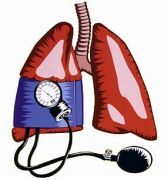Monotherapy with N-acetylcysteine No Better Than Placebo for Preserving Lung Function in Patients with Idiopathic Pulmonary Fibrosis
Study results showed treatment with N-acetylcysteine did not slow the decline in lung function, reduce acute exacerbations, or improve survival compared with placebo in patients with idiopathic pulmonary fibrosis.

Treatment with N-acetylcysteine (NAC) did not slow the decline in lung function, reduce acute exacerbations, or improve survival compared with placebo in patients with idiopathic pulmonary fibrosis.
During a session yesterday at the 2014 American Thoracic Society International Conference, Fernando J. Martinez, MD, executive vice chair of medicine at Weill Cornell Medical College, New York City, reviewed results from the PANTHER-IPF trial, which began in 2009 as a three-armed study comparing triple-therapy with azothiaprine plus prednisone plus NAC with placebo and NAC alone. In 2011, a safety alert following the deaths of several patients in the study resulted in the trial being suspended and the triple-therapy element of the protocol being eliminated.
After extensive evaluation of the data and IRB reviews at the many clinical sites, a modified protocol was introduced in January 2012 with the remaining two arms of the original protocol (NAC group and placebo group). Some patients continued from the original study, with a new informed consent procedure for the revised protocol, and additional patients were recruited. The first cohort of patients (ie, those continuing on the trial) were designated “Pre-Alert” and the second, newly-recruited, cohort of patients were designated “Post-Alert”.
Between December 2009 and July 2012, 264 patients were randomized to the study arms (133 into the NAC group and 131 into the placebo group). The mean age of the subjects was 67 years, 22% of patients were female and 96% were white. At the completion of the study, the remaining 159 subjects in the Pre-Alert cohort and 105 in the Post-Alert cohort were evaluated.
The primary outcome measure for the trial was the change in forced vital capacity (FVC) over a 60-week period. There were multiple secondary endpoints, including carbon monoxide diffusing capacity, 6-minute walk distance, and exacerbations. Comparing the NAC-treated group with the placebo-only group, there was no change in FVC (p=0.77). Furthermore, differences in the majority of the secondary parameters between the two groups did not attain statistical significance.
There was an unexpected discordance between the efficacy results for the Pre-Alert cohort, where 17 of 18 efficacy parameters were negative, and the Post-Alert cohort, where 15 of 18 parameters were positive.
The data was extensively reviewed to attempt to account for the discordant results for Pre- versus Post-Alert subjects. One explanation was that the placebo-treated groups in the two cohorts behaved differently. Meanwhile, the datasets in the NAC-treated groups were relatively consistent between the two cohorts.
Following the suggestion of the German investigators, researchers evaluated baseline values for the various endpoint parameters for the Pre-Alert versus Post-Alert cohorts but found no evidence of any significant differences between the two.
The rate of recruitment was significantly faster (by approximately 50%) for the Post-Alert cohort than Pre-Alert, but experience with clinical trials in general indicates this phenomenon is not usually a source of bias.
Following the presentation there was discussion about the results that touched on several topics, including biological mechanisms and possible genetic variations that might account for the discrepancies in results.
One questioner asked if there was a possibility that some patients were taking supplements containing NAC unbeknownst to the investigators, but Martinez said that study subjects were carefully questioned about any existing medications that might contain NAC.
Another member of the audience said, regarding the differences in enrollment rates for Pre- and Post-Alert cohorts, it was not unusual for enrollment to vary with calendar time, particularly if the sample size was small, and that there was a need for adequately powered studies to overcome this potential problem. Martinez replied that this argument could not explain why the change in enrollment rate coincided exactly with the transition from Pre-Alert to Post-Alert.
A third member of the audience asked if there might be a study center bias if new sites were introduced Post-Alert. Martinez confirmed that patients were recruited from new centers for the Post-Alert cohort.
There did not seem to be an adequate explanation for the discordant results.